
Welcome to milwaukeesnakes.com! I am David, a snake enthusiast living in Milwaukee, WI. Many people don't know that Milwaukee is in fact full of snakes! You just need to know where to find them - they can often be shy and elusive. Some Wisconsin snake species are more common outside of the city limits, in different parts of Milwaukee County WI, but many types of snakes are indeed common in the more urban parts of Milwaukee. This guide is meant to help educate you about the beautiful snakes of Milwaukee, and to help you identify the most common snakes of Milwaukee, as well as the venomous snakes of Milwaukee that you should learn to recognize and avoid. If you want more detail, click here for my complete list of ALL snake species in Milwaukee. Remember the following:
- Most snakes of Milwaukee are harmless and don't want to encounter you
- Venomous snakes exist but are uncommon in Milwaukee, Wisconsin
- Snakes eat rats and mice and are a valuable part of the Wisconsin ecosystem
- Never kill a snake - if you leave a snake alone, it will leave you alone.
Common Snake Species in Milwaukee
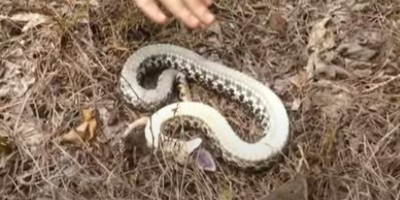 Eastern hognose snake:
The eastern hognose snake (puff adder) belongs to the family Colubridae. They are medium-sized snakes, with a size of 20-35 inches. These snakes have dark brown patches, on a golden-brown ground color, and the underside ranges from molted yellow to molted gray or pink, although adults are mostly dark brown, or grey, or have no pattern at all. Many of the eastern hognose snakes have two dark black spots on their neck, making them look like eyespots when flattened. They live in oak savannas, sand prairies, bracken grasslands, and in the southern forests. They feed extensively on amphibians like toads, frogs, salamanders, birds, invertebrates, and small mammals.
Eastern hognose snake:
The eastern hognose snake (puff adder) belongs to the family Colubridae. They are medium-sized snakes, with a size of 20-35 inches. These snakes have dark brown patches, on a golden-brown ground color, and the underside ranges from molted yellow to molted gray or pink, although adults are mostly dark brown, or grey, or have no pattern at all. Many of the eastern hognose snakes have two dark black spots on their neck, making them look like eyespots when flattened. They live in oak savannas, sand prairies, bracken grasslands, and in the southern forests. They feed extensively on amphibians like toads, frogs, salamanders, birds, invertebrates, and small mammals.
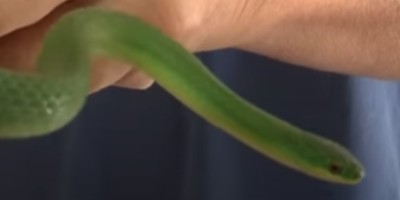 Smooth green snake:
The smooth green snake (also called the green snake because of its color) belongs to the family Colubridae. In addition to their bright emerald green color, their scales give them a smooth, sleek appearance and texture. When hatched, young green snakes are olive-green in color. They have a size of 14-20 inches. Smooth green snakes can be found in prairies, bracken grasslands, open areas in pine barrens, and oak savannas. Their main diet is insects, especially crickets, caterpillars, and grasshoppers. They also eat centipedes, beetles, spiders, snails, slugs, frogs, and toads.
Smooth green snake:
The smooth green snake (also called the green snake because of its color) belongs to the family Colubridae. In addition to their bright emerald green color, their scales give them a smooth, sleek appearance and texture. When hatched, young green snakes are olive-green in color. They have a size of 14-20 inches. Smooth green snakes can be found in prairies, bracken grasslands, open areas in pine barrens, and oak savannas. Their main diet is insects, especially crickets, caterpillars, and grasshoppers. They also eat centipedes, beetles, spiders, snails, slugs, frogs, and toads.
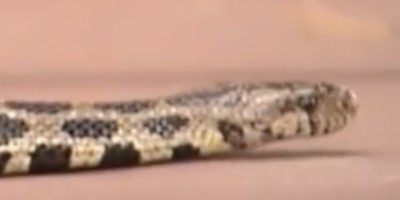 Western fox snake:
The fox snake has many reddish-brown colors, or chocolate brown colors, or black mid-dorsal large patches down its back, smaller patches on its side, with its yellow, tan, or olive-gray ground color. Adult fox snakes usually have rust or orange, or dark copper heads, and as a result, they are often thought to be poisonous copperhead snakes. They have a size of 36-56 inches. They are found in open habitats, like marshes, sedge meadows, open fields, and prairies. They feed on mice and birds nesting on the ground. Young ones feed on amphibians like frogs.
Western fox snake:
The fox snake has many reddish-brown colors, or chocolate brown colors, or black mid-dorsal large patches down its back, smaller patches on its side, with its yellow, tan, or olive-gray ground color. Adult fox snakes usually have rust or orange, or dark copper heads, and as a result, they are often thought to be poisonous copperhead snakes. They have a size of 36-56 inches. They are found in open habitats, like marshes, sedge meadows, open fields, and prairies. They feed on mice and birds nesting on the ground. Young ones feed on amphibians like frogs.
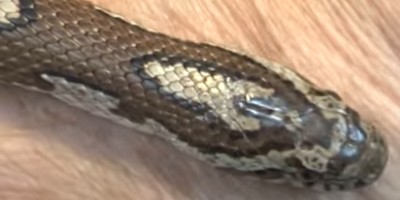 Eastern milksnake:
The eastern milksnake has a ground color that's grey or light brown, having three rows of brown or reddish-brown patches with black borders. On the head, towards the neck, there is usually a white-colored Y- or V-shaped marking. The eastern milksnake has a size of 24-36 inches. Eastern milksnakes occur in northern and southern upland hardwoods, pastures, old woodlots, and prairies. They feed on rodents like mice and other snakes too.
Eastern milksnake:
The eastern milksnake has a ground color that's grey or light brown, having three rows of brown or reddish-brown patches with black borders. On the head, towards the neck, there is usually a white-colored Y- or V-shaped marking. The eastern milksnake has a size of 24-36 inches. Eastern milksnakes occur in northern and southern upland hardwoods, pastures, old woodlots, and prairies. They feed on rodents like mice and other snakes too.
Venomous Snake Species in Milwaukee
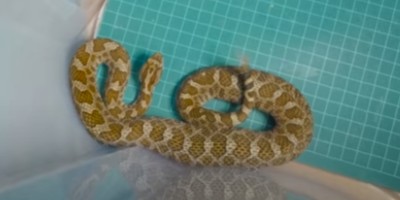 Eastern massasauga rattlesnake:
This endangered snake species belongs to the family Viperidae. The name massasauga is derived from the Chippewa language, and it means great river mouth. Massasauga rattlesnakes have a size of 20-32 inches, and the body of a medium-sized rattlesnake. The eastern massasauga rattlesnake has a tanned to light grey color, with a large mid-dorsal, and lightly edged to blackish patches. They also have a ringed tail, with bands that are wide and blackish too. They have a black stripe running down each eye and down to the neck. Northern massasauga rattlesnakes occur in flood plains, along with medium to large rivers, river bottom lowland forests, and open wetlands, such as freshwater meadows, adjacent upland prairies, and sedge meadows. The eastern massasauga rattlesnake feeds on small rodents like mice and voles. They also feed on lizards, snakes, and amphibians like frogs.
Eastern massasauga rattlesnake:
This endangered snake species belongs to the family Viperidae. The name massasauga is derived from the Chippewa language, and it means great river mouth. Massasauga rattlesnakes have a size of 20-32 inches, and the body of a medium-sized rattlesnake. The eastern massasauga rattlesnake has a tanned to light grey color, with a large mid-dorsal, and lightly edged to blackish patches. They also have a ringed tail, with bands that are wide and blackish too. They have a black stripe running down each eye and down to the neck. Northern massasauga rattlesnakes occur in flood plains, along with medium to large rivers, river bottom lowland forests, and open wetlands, such as freshwater meadows, adjacent upland prairies, and sedge meadows. The eastern massasauga rattlesnake feeds on small rodents like mice and voles. They also feed on lizards, snakes, and amphibians like frogs.
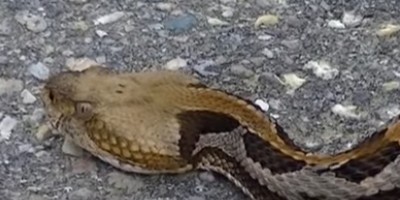 Timber rattlesnake:
The timber rattlesnake is protected by law because it is endangered, especially by humans. Their size ranges from 36-56 inches, and they have a heavy body. The ground color of the timber rattlesnake ranges from yellow to rusty orange to brown or gray. They have dark brown to black crossbar markings. The color of their head is light gold, while their tail is black, with a tan rattle at its end. They are found in rugged open bluffs of southwestern and western Wisconsin. Sometimes, they relocate to deciduous forests and croplands. They feed on rodents like mice, chipmunks, voles, and reptiles like lizards and small snakes; they also eat frogs, insects, and dead meat.
Timber rattlesnake:
The timber rattlesnake is protected by law because it is endangered, especially by humans. Their size ranges from 36-56 inches, and they have a heavy body. The ground color of the timber rattlesnake ranges from yellow to rusty orange to brown or gray. They have dark brown to black crossbar markings. The color of their head is light gold, while their tail is black, with a tan rattle at its end. They are found in rugged open bluffs of southwestern and western Wisconsin. Sometimes, they relocate to deciduous forests and croplands. They feed on rodents like mice, chipmunks, voles, and reptiles like lizards and small snakes; they also eat frogs, insects, and dead meat.
If you're unsure, you can email me a photo of the snake at info@milwaukeesnakes.com and I will email you back with the snake's species. If you found a snake skin, read my Found a Skin? page, and you can email me a photo of the skin, and I'll identify the snake for you. If you need professional Milwaukee snake removal help, click my Get Help page, or see the below website sponsor I found, who provides that service.
Remember, the term is not poisonous snakes of Milwaukee, it's venomous snakes of Milwaukee. Poison is generally something you eat, and venom is injected into you. That said, dangerous snakes are very rare in Milwaukee. The few venomous snakes of Milwaukee County are rarely seen. But they are commonly misidentified, so learn about all the snake species of Milwaukee in order to correctly identify them. These snakes are usually also found in the surrounding towns of Wauwatosa, West Allis, Oak Creek, Glendale, Franklin, Greenfield, Cudahy, Brown Deer, South Milwaukee, Shorewood, Saint Francis, Whitefish Bay, Greendale, Fox Point, West Milwaukee, Hales Corners, River Hills and the surrounding areas.
Read our article about:
How do You Find a Lost Snake?
milwaukeesnakes.com domain and hosting costs made possible by the generous support of this sponsor:
